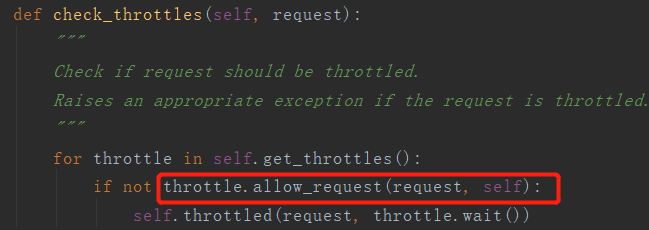自定义访问频率控制类结构
views.py
from rest_framework.throttling import BaseThrottle
import time
# 节流
visit_dict={}
class Visitthrottle(BaseThrottle):
#通过IP做唯一标识符
#问题:非登陆用户一分钟内只允许访问3次
def __init__(self):
self.history=None
def allow_request(self,request, view):
#获取IP地址
remote_addr = self.get_ident(request)
ctime=time.time()
if remote_addr not in visit_dict:
visit_dict[remote_addr]=[ctime,]
return True
self.history = visit_dict.get(remote_addr)
while self.history and self.history[-1] <ctime - 60:
self.history.pop()
if len(self.history)<3:
self.history.insert(0,ctime)
return True
def wait(self):
ctime=time.time()
return 60-(ctime-self.history[-1])
class TestThrottle(APIView):
throttle_classes
=
[VisitThrottle,]
def
get(
self
, request,
*
args,
*
*
kwargs):
pass
'''
等等一系列的视图功能方法
'''
实现原理分析:
- 需要使用用户IP地址作为唯一标识符,如果使用用户登陆账号作为唯一标识符,一个用户可能拥有多个账号,则达不到节流的目的,但使用IP地址也不是说一定不能改变,但相比于登陆账号,使用IP地址更能达到节流的作用。
- 以IP地址作为KEY键,多个访问时间形参列表作为value存入字典中,用户每次访问读取字典,判断最后一次访问时间与这次访问时间相差时间,相差时间大于60秒,删除时间列表中最后元素,然后判断列表长度是否小于3,如果小于3,表示一分钟内未访问3次,允许继续访问。
- 如果不允许访问,会执行wait函数,返回需要等待时间。
- 但是在项目开发中不使用自定义节流类,是因为drf中已经实现了节流方法。内置接口代码基本结构,内置节流类的实现原理与自定义节流类原理相同。
内置节流类结构
settings.py:
REST_FRAMEWORK = {
'DEFAULT_THROTTLE_CLASSES':['api.utils.mythrottle.UserThrottle',]
'DEFAULT_THROTTLE_RATES': {
'未认证用户': '10/m',
'已认证用户': '100/h',
},
}
mythrottle.py:
from rest_framework.views import APIView
from rest_framework.response import Response
from rest_framework import exceptions
from rest_framework.throttling import SimpleRateThrottle
class VisitThrottle(SimpleRateThrottle):
scope = "未认证用户"
def get_cache_key(self, request, view):
return self.get_ident(request)
class UserThrottle(SimpleRateThrottle):
scope = "已认证用户"
def get_cache_key(self, request, view):
return request.user # 认证通过后,认证方法authenticate的返回值之一<br><br>
class TestThrottle(APIView):<br> # 这样设置后,节流功能就会使用VisitThrottle类,而不会使用UserThrottle类
throttle_classes = [VisitThrottle,]
def get(self, request, *args, **kwargs):
pass
'''
等等一系列的视图功能方法
'''
这里使用的节流类是继承了SimplePateThrottle类,而这个类利用了django内置的缓存来存储访问记录。通过全局节流设置,所有的视图类默认是使用UserThrottle类进行节流,如果不想使用默认的类就自定义给throttle_classes属性变量赋值,如:“throttle_classes = [VisitThrottle,]”。看到内置节流类的使用,可能一脸懵逼,下面进行源码分析。
源码分析
与之前认证,权限控制的源码分析方法一致,先进入函数入口dispatch方法,封装完新的request对象后,进入initialize_request方法,我们会发现还有一个函数调用我们没有分析,所以这就是我们的节流函数。

1.为什么会使用scope属性变量,有什么用?
进入check_throttles函数,是否觉得很熟悉?没错在get_throttles方法中肯定也是一个列表生产式,返回一个有节流类实例组成的列表。


在列表生成式中,先对内置类SimplePateThrottle进行实例化,在实例化中去拿到scope的值,并且根据值作为key值去配置文件中拿到对应value值。
